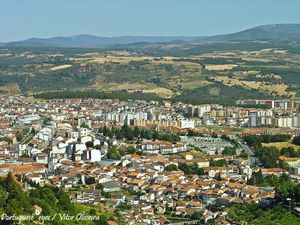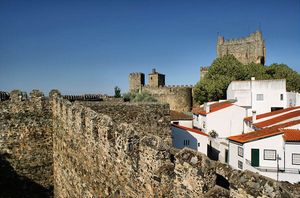
Bragança, Portugal
Don’t miss discovering the city of Bragança while in the North of Portugal.
Bragança, the historical capital of the region of Tras-os-Montes, is at once a city of vast avenues and a medieval town with battlements. These will grant you the panoramic views of the fields, forest, and small farms enjoyed for centuries.
The most iconic attraction in the city is the old walled citadel standing atop a hill in the easternmost extreme of Bragança. After crossing it’s arched entrance, you will find yourself in an excellently preserved medieval neighbourhood. Don’t miss the Bragança Castle, the Torre da Princesa and Keep.
The main axis of the city (Av. João da Cruz, Rua Almirante Reis, Rua Combatentes da Grande Guerra y Rua Trindade Coelho) flows towards the southeast, from the bus station to the citadel. The Praça de Sé (Cathedral Square) is the hub of the city.
Among the rooftops of the citadel, two buildings stand out: the belltower of the Igreja da Santa María church, and the Keep of the Bragança Castle, decorated with fashionable Gothic windows. To cross the walls, you have to go along a passageway with two gates, the first nicknamed “Porta de San António,” and the other “Porta da Vila.”
On one side of the castle, a small square full of century-old trees is the setting of the ancient Gothic “Pelourinho,” the base of which is the figure of a pre-Roman wild boar. The statue of the boar is believed to date back to as far as the Iron Age.
One of the most interesting monuments in the city is the Domus Municipalis, an old town hall with an irregular floorplan and influences of Medieval styles. It was erected in the 12th century and is almost annexed to the Igreja de Santa María church.
Towards the bottom of the citadel, before entering the lowest part of the city, stands the Igreja de São Vicente Church, Romanesque in origin, where legend assures that the secretive wedding of King Dom Pedro and Queen Doña Inês de Castro took place.
In the Rua Abilio Beça street, you can visit the Museu do Abade de Baçal (Abbot of Baçal Museum), which occupies the two floors and gardens of the former Episcopal Palace, and where artworks and archaeological remains are exhibited.
In the lowest part of the city, it’s worth visiting the Sé or Old Cathedral of Bragança, former Jesuit church with Baroque chapels and an interior decoration based on tile panels.
In front of the Cathedral, a Cruceiro (calvary sculpture) from 1869 on top of a Solomonic column.
In the surrounding area to the Praça da Sé square, you can visit several buildings that are part of the city’s heritage, such as the Igreja da Misericórdia Church, decorated with tiles; the Solar dos Calaínhos (17th century), with its nine doors and the coat of arms of the Samentos Pimentéis Morais e Ferreiras family; or the Solar dos Veiga Cabral (1764), nowadays housing the Contemporary Art Centre.
Close by, in Rua Dr. Herclano de Conceição stret, you shouldn’t miss visiting the Dr. Belarmino Formoso Ethnography museum.
Visiting Bragança is not, as many say, limited to the citadel and the cathedral area, since Bragança is one of the cities in Portugal that have best adapt to these changing times. It features a urban planning full of vast avenues, and circuses featuring sculptures of great value and symbolism. The best examples can be found in the Rotunda 23 de Abril, Rotunda Homenagem ao Lavrador, and the Rotunda do Sabor.
As for new buildings, the Filipe Oliveira Dias City Theatre, in Praça Professor Cavaleiro de Ferreira Square, and the Fórum Theatrum Mall are both unique examples of the new ways of this changing Portuguese city.
The city was known as Bragantia by the Celts and Juliobriga by the Romans. It is a century-old city located just a few kilometres from the border with Spain, which made the city a common setting for skirmishes and full-blown wars between Spain and Portugal.
It’s walled citadel was erected by Alfonso Henriques, first king of Portugal in 1130; whereas his son, Sancho I, improved the fortifications and ordered the building of Bragança Castle after taking the king from the kingdom of Leon in 1187.
In 1442, King Alfonso V created the Duchy of Bragança for his uncle, who was the bastard son of King JoãoI, giving raise to one of the wealthiest and most powerful families of Portugal.
Bragaça exerted an important role during the Napoleonic wars being the very place form which Sapúlveda exhorted to resist the French troops.
An interesting period during which to visit Bragança is early May, when Bragança hosts the three-day-long Feira das Cantarinhas, the largest street craft festival in the region.
In the surrounding area, it’s also worth visiting the Montesinho Natural Park, and the towns of Miranda do Douro and Mirandela.
Mapa Interactivo:
Bragança
What to see:
- Bragança Castle
- Bragança Museum of the Military
- Domus Municipalis of Bragança
- Igreja de Santa Maria Mother Church of Bragança
- Old Cathedral of Bragança
- Igreja de São Vicente Church
- Igreja de São Bento Church
- Museu Ibérico da Máscara e do Traje Museum
- Graça Morais Contemporary Art Museum
- Abade de Baçal Museum
- Castro de Avelãs Monastery
- Miradouro do Santuário de São Bartolomeu Lookout
- Dr. Belarmino Afonso Ethnographic Museum
- Montesinho Natural Park
- Mirandela
- Távoras Palace
- Miranda do Douro
- Museu da Terra de Miranda Museum
- Sé or Former Cathedral of Miranda do Douro
Other worth-visiting nearby towns and cities:
Why "Portugal Travel"?
Portugal Travel is an organization of Portuguese agencies whose objectives are:
- ✓ To make Portugal, its culture and its heritage known.
- ✓ To promote sustainable tourism.
In collaboration with:
Escola Superior de Hotelaria e Turismo do Estoril
Turismo de Portugal
Copyright PortugalTravel.org © - All rights reserved.






